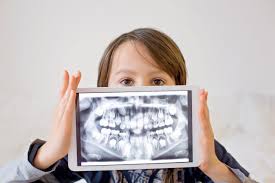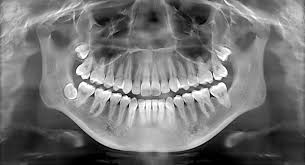Dental X-Ray
Also known as dental radiographs, dental X-rays use controlled pulses of radiation to create images of the internal structures of the jaw and mouth.


During a dental X-ray procedure, the dental technician places a protective lead apron over your chest and a thyroid collar around your neck to ensure complete safety. The X-ray sensor or film is then positioned inside your mouth to capture detailed images.
At The Dental Hut, a leading dental clinic in Airoli, we follow modern guidelines for radiation safety. According to updated ADA recommendations, healthy adults without signs of gum disease or tooth decay typically need dental X-rays only once every 2–3 years. However, your dentist will recommend the ideal frequency based on your oral health condition.
If you're looking for a dentist in Airoli, dental clinic near you, or the best dentist in Airoli, our team ensures safe imaging, accurate diagnosis, and complete comfort for patients of all ages — including children, making us a trusted kids dentist in Airoli as well.
How are dental X-rays taken?
Dental x-rays are taken with you sitting upright in a chair.
Why Are X-Rays Necessary At The Dentist?
X-Rays let dentists look deeper than the surface, X-rays consist of images taken using high-energy electromagnetic radiation. Soft, low-density tissue such as our skin and organs cannot absorb this radiation, so it will mostly pass through this tissue.
Tips before going to the procedure
Pregnant or thinking you may be pregnant
If you are pregnant or thinking you may be pregnant, tell your doctor before going to the procedure because there may be a small risk that radiation can harm the fetus.
Difficulty Standing
Tell your doctor/dentist if you have any difficulty in standing for a longer time.


Dental X-rays can show diseases of the mouth, including the teeth and gums, that would otherwise go undetected. These diseases include potentially serious conditions such as the following: An abscess, or infection at the root of a tooth or between the gum and a tooth. Areas of decay that are not visually detectable.
Founded in 2014, The Dental Hut, Airoli was established with a commitment to provide reliable, ethical, and comfort-focused dental care for every patient. Our clinic brings together modern technology, skilled clinical expertise, and a warm, patient-friendly approach — ensuring that every treatment is carried out with precision and trust.

SERVING AND CARING FOR YOU SINCE 2014
Address :
Plot no B/21, opp. Apple Hospital, Sector 7, Airoli, Navi Mumbai, Maharashtra 400708
Timings :
Monday to Saturday:
10:00 AM to 1:50 PM & 5:30 PM to 9:50 PM
Sunday: Closed
Phone :
+91 8451922257 / +91 8369910225
Quick Links
Home
About us
Treatments
Gallery
Blog
Contact
